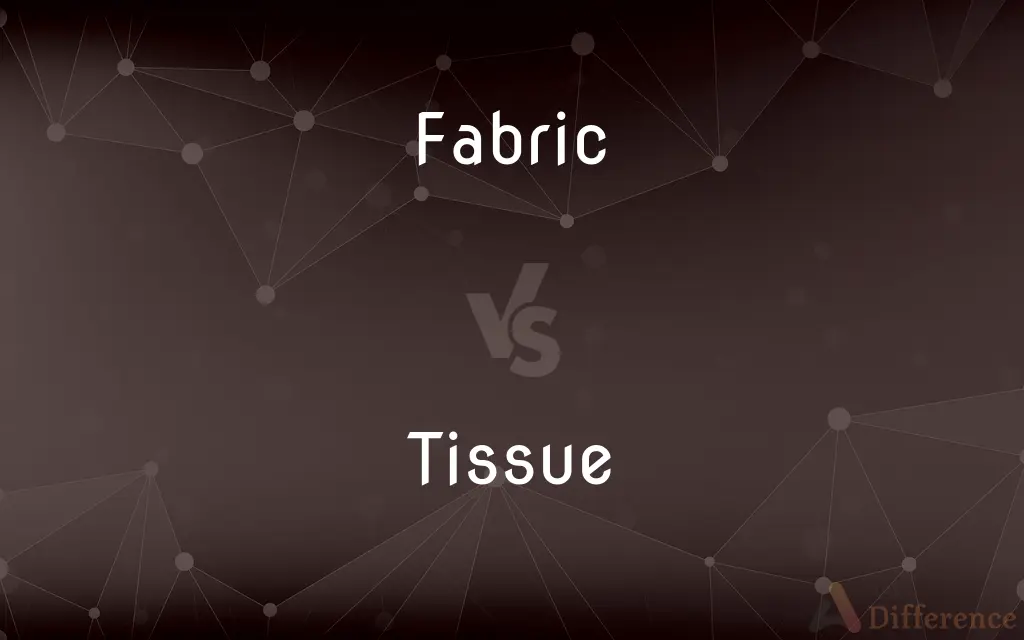Fabric vs. Tissue — What's the Difference?
By Fiza Rafique & Urooj Arif — Updated on April 6, 2024
Fabric is a material made by weaving, knitting, or felting fibers, often used for clothing or upholstery, whereas tissue refers to thin sheets of paper or a group of cells in organisms performing specific functions.

Difference Between Fabric and Tissue
Table of Contents
ADVERTISEMENT
Key Differences
Fabric is created through processes like weaving, knitting, or felting, utilizing various fibers such as cotton, wool, and synthetic materials. These methods intertwine fibers to form a cohesive and often durable material. On the other hand, tissue can refer to either thin sheets of soft paper used for hygiene or wrapping or to specialized groups of cells in living organisms that perform specific functions, such as muscle or nervous tissue.
Fabric is versatile and serves numerous purposes, ranging from clothing and accessories to home furnishings and industrial applications. Its strength, texture, and appearance vary based on its composition and construction method. Tissue, in its paper form, is primarily designed for single-use applications focusing on hygiene, convenience, and softness, while in a biological context, it is crucial for the structure and function of organisms.
The production of fabric involves a series of complex steps including spinning, weaving or knitting, and often finishing treatments to enhance properties like durability, colorfastness, and comfort. Tissue paper manufacturing, however, is a process of recycling or virgin fiber processing, which is then pressed, dried, and sometimes embossed to create softness and absorbency. Biological tissues are formed through cellular differentiation and organization, a natural process driven by genetic and environmental factors.
Consumer choices in fabrics are influenced by factors like texture, durability, care requirements, and environmental impact. These preferences are shaped by the intended use, be it for fashion, interior design, or technical applications. In contrast, tissue paper choices are often based on softness, strength, and absorbency, with environmental sustainability increasingly becoming a concern. Selection of biological tissues for medical or research purposes is dictated by specific functional requirements and compatibility.
The environmental impact of fabric production varies widely, with natural fibers like cotton and wool having different footprints compared to synthetic fibers like polyester, in terms of water use, pesticides, and energy consumption. Tissue paper, particularly from recycled sources, has a different set of environmental considerations, including deforestation, water use, and chemical pollution. Conservation efforts in biological tissue research focus on ethical sourcing and minimizing harm to living organisms.
ADVERTISEMENT
Comparison Chart
Definition
Material made by interlocking fibers.
Thin sheets of paper or a group of cells with a specific function.
Primary Use
Clothing, upholstery, industrial.
Hygiene, wrapping, or biological structure/function.
Production Process
Weaving, knitting, felting fibers.
Paper: recycling or virgin fiber processing. Biological: cellular differentiation.
Selection Criteria
Texture, durability, care, environmental impact.
Softness, strength, absorbency, functionality.
Environmental Impact
Varied by fiber type: water, pesticides, energy.
Deforestation, water use, chemical pollution, ethical sourcing.
Compare with Definitions
Fabric
A material produced by entangling fibers through felting.
The artisan created a durable fabric from wool rovings.
Tissue
A thin, soft paper for personal hygiene.
She reached for a tissue to wipe her eyes.
Fabric
A woven or knitted material used for clothes.
The designer chose a soft silk fabric for the evening gown.
Tissue
A group of cells performing a specific function in organisms.
Muscle tissue is crucial for movement.
Fabric
A decorative material used in home furnishings.
They selected a vibrant fabric to reupholster the vintage sofa.
Tissue
A wrap or packaging material.
The gift was wrapped in a delicate tissue paper.
Fabric
A technical material designed for specific functions.
The laboratory developed a breathable fabric for medical use.
Tissue
A biological term for cellular organization.
Scientists studied the regeneration of liver tissue in the lab.
Fabric
A synthetic material used in various applications.
The outdoor furniture was covered in a weather-resistant fabric.
Tissue
An essential component in medical research.
The study focused on the behavior of neural tissue under stress.
Fabric
A cloth produced especially by knitting, weaving, or felting fibers.
Tissue
A fine, very thin fabric, such as gauze.
Fabric
The texture or quality of such cloth.
Tissue
Tissue paper.
Fabric
A complex underlying structure
Destroyed the very fabric of the ancient abbey during wartime bombing.
Needs to protect the fabric of civilized society.
Tissue
A soft, absorbent piece of paper used as toilet paper, a handkerchief, or a towel.
Fabric
A method or style of construction.
Tissue
An interwoven or interrelated number of things; a web; a network
"The text is a tissue of mocking echoes" (Richard M. Kain).
Fabric
A structural material, such as masonry or timber.
Tissue
(Biology) An aggregation of morphologically similar cells and associated intercellular matter acting together to perform one or more specific functions in an organism. There are four basic types of tissue in many animals
Muscle, nerve, epidermal, and connective.
Fabric
A physical structure; a building.
Tissue
Thin, woven, gauze-like fabric.
Fabric
An edifice or building.
Tissue
A fine transparent silk material, used for veils, etc.; specifically, cloth interwoven with gold or silver threads, or embossed with figures.
Fabric
(archaic) The act of constructing, construction, fabrication.
Tissue
A sheet of absorbent paper, especially one that is made to be used as tissue paper, toilet paper or a handkerchief.
Fabric
(archaic) The structure of anything, the manner in which the parts of a thing are united; workmanship, texture, make.
Cloth of a beautiful fabric
Tissue
Absorbent paper as material.
Fabric
The physical material of a building.
This church dates back to the 11th century, though the great majority of its fabric is fifteenth century or later.
Tissue
(biology) A group of cells (along with their extracellular matrix if any) that are similar in origin and function together to do a specific job.
Fabric
The framework underlying a structure.
The fabric of our lives
The fabric of the universe
Tissue
Web; texture; complicated fabrication; connected series.
A tissue of forgeries, or of lies
Fabric
A material made of fibers, a textile or cloth.
Cotton fabric
Tissue
The scratch sheet or racing form.
Fabric
The texture of a cloth.
Tissue
To form tissue of; to interweave.
Fabric
(petrology) The appearance of crystalline grains in a rock.
Tissue
A woven fabric.
Fabric
(computing) Interconnected nodes that look like a textile fabric when diagrammed.
The Internet is a fabric of computers connected by routers.
Tissue
A fine transparent silk stuff, used for veils, etc.; specifically, cloth interwoven with gold or silver threads, or embossed with figures.
A robe of tissue, stiff with golden wire.
In their glittering tissues bear emblazedHoly memorials.
Fabric
(transitive) To cover with fabric.
Tissue
One of the elementary materials or fibres, having a uniform structure and a specialized function, of which ordinary animals and plants are composed; a texture; as, epithelial tissue; connective tissue.
Fabric
The structure of anything; the manner in which the parts of a thing are united; workmanship; texture; make; as cloth of a beautiful fabric.
Tissue
Fig.: Web; texture; complicated fabrication; connected series; as, a tissue of forgeries, or of falsehood.
Unwilling to leave the dry bones of Agnosticism wholly unclothed with any living tissue of religious emotion.
Fabric
That which is fabricated
Anon out of the earth a fabric hugeRose like an exhalation.
Tissue
To form tissue of; to interweave.
Covered with cloth of gold tissued upon blue.
Fabric
Cloth of any kind that is woven or knit from fibers, whether vegetable, animal, or synthetic; manufactured cloth; as, silks or other fabrics; made of a fabric that is 50% cotton and 50% polyester.
Tissue
A part of an organism consisting of an aggregate of cells having a similar structure and function
Fabric
The act of constructing; construction.
Tithe was received by the bishop, . . . for the fabric of the churches for the poor.
Tissue
A soft thin (usually translucent) paper
Fabric
Any system or structure consisting of connected parts; as, the fabric of the universe.
The whole vast fabric of society.
Tissue
Create a piece of cloth by interlacing strands of fabric, such as wool or cotton;
Tissue textiles
Fabric
To frame; to build; to construct.
Fabric
Artifact made by weaving or felting or knitting or crocheting natural or synthetic fibers;
The fabric in the curtains was light and semitraqnsparent
Woven cloth originated in Mesopotamia around 5000 BC
She measured off enough material for a dress
Fabric
The underlying structure;
Restoring the framework of the bombed building
It is part of the fabric of society
Common Curiosities
What is fabric?
Fabric is a material made by weaving, knitting, or felting fibers, used in various applications like clothing and furnishings.
What is tissue?
Tissue can refer to thin sheets of paper used for personal hygiene or wrapping, or to a group of specialized cells in organisms performing specific functions.
How is fabric made?
Fabric is made through processes like weaving, knitting, or felting, where fibers are interlocked to create a cohesive material.
Can fabric be recycled?
Yes, many fabrics can be recycled, though the process and feasibility vary depending on the material type.
What makes tissue paper soft?
Softness is achieved through the manufacturing process, including the materials used and treatments like embossing.
What are the environmental impacts of fabric production?
The environmental impact varies, with factors like water use, pesticides, and energy consumption differing between natural and synthetic fibers.
How is tissue paper made?
Tissue paper is made from recycled or virgin fibers that are pressed, dried, and sometimes embossed to create softness and absorbency.
What are the uses of fabric in industry?
In industry, fabric is used for clothing, furnishings, protective gear, and as components in products like filters and insulation.
What factors influence fabric choice?
Factors include texture, durability, care requirements, and environmental impact, depending on the intended use.
Why is tissue paper important in hygiene?
Tissue paper is important for hygiene because it provides a disposable, sanitary way to clean and dry hands and surfaces, reducing the spread of germs.
What are the types of tissue?
Tissue types include paper tissue used for hygiene and wrapping, and biological tissue, which is a group of cells in organisms with a specific function.
Is tissue paper biodegradable?
Most tissue papers are biodegradable, especially those made from natural fibers, but their environmental friendliness can vary based on chemicals used in processing.
What is the difference between fabric and cloth?
Fabric generally refers to any material made by weaving, knitting, or felting fibers, whereas cloth often refers to a piece of fabric used for a specific purpose.
How are biological tissues studied?
Biological tissues are studied through various methods, including microscopy, biochemical assays, and genetic analysis, to understand their function and structure.
What is the significance of tissue in medical research?
Tissue is crucial in medical research for understanding disease mechanisms, testing treatments, and exploring regenerative medicine.
Share Your Discovery

Previous Comparison
Suspect vs. Victim
Next Comparison
Absorption vs. StrippingAuthor Spotlight
Written by
Fiza RafiqueFiza Rafique is a skilled content writer at AskDifference.com, where she meticulously refines and enhances written pieces. Drawing from her vast editorial expertise, Fiza ensures clarity, accuracy, and precision in every article. Passionate about language, she continually seeks to elevate the quality of content for readers worldwide.
Co-written by
Urooj ArifUrooj is a skilled content writer at Ask Difference, known for her exceptional ability to simplify complex topics into engaging and informative content. With a passion for research and a flair for clear, concise writing, she consistently delivers articles that resonate with our diverse audience.
















































